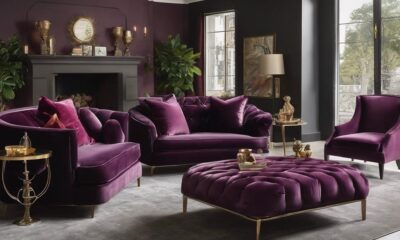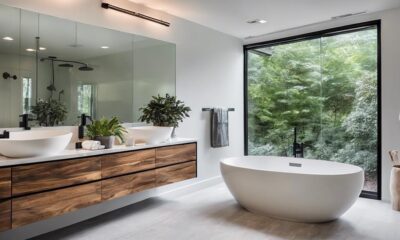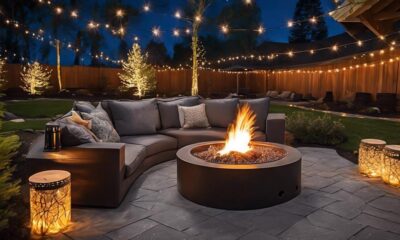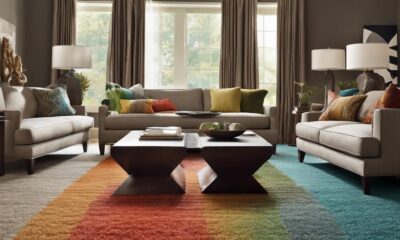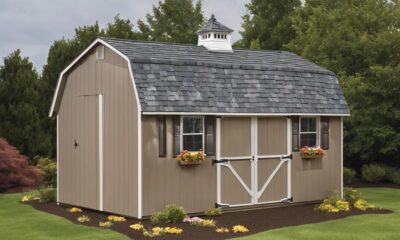Decor
Can You Bake Acrylic Paint in the Oven
Hoping to elevate your acrylic paint projects? Discover the surprising answer to whether you can bake acrylic paint in the oven.

While we’re in the kitchen, imagining the vivid hues and sleek surface of our acrylic painting endeavor, we’re faced with a curious inquiry – is it possible to harden acrylic paint by baking it in the oven? This concept is captivating, yet there are several aspects we need to think about before moving forward.
Safety precautions, suitable surfaces, temperature and time adjustments, and the benefits versus risks of baking acrylic paint all play a crucial role in the outcome of our artistic endeavor.
Let’s explore the intricacies of this process and uncover the tips and tricks for achieving professional results with our baked acrylic paint projects.
Key Takeaways
- Proper ventilation is essential to prevent inhalation of toxic fumes when baking acrylic paint.
- Using a dedicated oven for baking acrylic paint helps avoid cross-contamination.
- It is important to choose suitable surfaces like ceramics, glass, and certain types of clay for baking acrylic paint.
- Following the recommended baking temperature and time provided by the paint manufacturer ensures the best results.
Safety Precautions When Baking Acrylic Paint

When baking acrylic paint, it’s imperative to ensure proper ventilation in the area to prevent inhalation of fumes. Toxic fumes can be released during the baking process, so it’s crucial to work in a well-ventilated space or use a fume hood.
Additionally, using a dedicated oven for baking acrylic paint is essential to prevent the release of harmful chemicals into an oven used for food. This precaution helps to mitigate the risk of cross-contamination and exposure to toxic substances.
Furthermore, wearing oven mitts when handling hot items is crucial to prevent burns or injuries. The high temperatures required for baking acrylic paint can result in severe burns if proper protective gear isn’t used.
It’s also important to allow the painted items to cool completely before handling them to avoid burns or damage to the paint.
Checking the label of the acrylic paint to ensure it’s suitable for baking and following the manufacturer’s instructions carefully is fundamental to guaranteeing a safe and successful baking process.
Suitable Surfaces for Baking Acrylic Paint
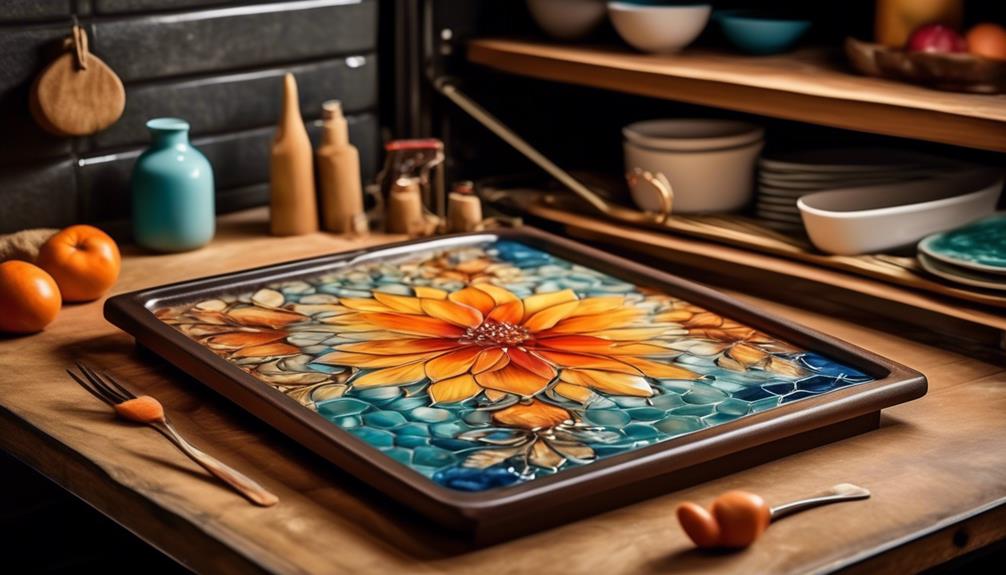
When considering suitable surfaces for baking acrylic paint, it’s important to choose heat-resistant painting bases such as ceramics, glass, and certain types of clay. These surfaces are designed to withstand the high temperatures involved in the baking process, ensuring that the paint adheres properly and maintains its durability.
Additionally, ensuring that the surface is clean and free from any contaminants before applying and baking acrylic paint is crucial for achieving the best results.
Safe Surfaces for Baking
Ceramics and pottery surfaces, as well as certain types of glassware, are suitable for baking acrylic paint. These surfaces produce a durable, dishwasher-safe finish when baked properly. It’s important to ensure that the chosen surface is labeled as oven-safe and does not release toxic chemicals when heated. Non-porous surfaces, such as ceramics and certain types of glass, are best for proper adhesion and durability. Selecting heat-resistant materials that can withstand high temperatures is crucial. Always follow the manufacturer’s instructions for the specific type of paint being used, as different acrylic paints may have varying heat requirements. The general baking process involves placing the painted item in a cold oven, setting the temperature to around 275 degrees F, and allowing it to bake for approximately 30 minutes.
Heat-Resistant Painting Bases
Safe surfaces for baking acrylic paint include ceramics, glassware, clay pots, oven-safe dishes, and heat-resistant tiles, all of which provide durable and long-lasting results when used properly.
- Ceramic and porcelain: Suitable for baking acrylic paint, creating durable and dishwasher-safe finishes.
- Glassware: Can be baked with acrylic paint, providing a permanent and heat-resistant finish.
- Clay pots and pottery: Ideal for baking acrylic paint, ensuring long-lasting and weather-resistant results.
- Oven-safe dishes: Suited for baking acrylic paint, offering a durable and heat-resistant surface for everyday use.
These surfaces can withstand the heat required to bake acrylic paint, typically around 275 degrees Fahrenheit, allowing the paint to cure and form a strong bond to the base. When using these heat-resistant bases, it’s essential to follow proper baking instructions for optimal results.
Baking Temperature and Time for Acrylic Paint
To ensure optimal results when baking acrylic paint, it’s essential to adhere to the recommended temperature and time parameters provided by the paint manufacturer. When using an oven for the bake method, the baking temperature for acrylic paint typically ranges between 300 to 350 degrees Fahrenheit. It’s crucial to note that this temperature range may vary slightly based on the specific instructions provided by the paint manufacturer.
Additionally, the recommended baking time for acrylic paint generally falls within the range of 30 to 45 minutes. However, it’s important to refer to the instructions on the acrylic paint label or packaging for the exact baking temperature and time, as these may differ based on the type of acrylic paint being used.
Furthermore, after the baking process is complete, it’s imperative to allow the baked acrylic paint to cool completely before handling or using the painted item. Adhering to these specific temperature and time parameters is vital for achieving the best results when using the bake method for acrylic paint projects.
Benefits of Baking Acrylic Paint

Baking acrylic paint in an oven offers several advantages, including speeding up the drying process and ensuring a strong bond with the surface for long-lasting results.
- Strong Bond: Baking acrylic paint helps it form a strong bond with the surface, ensuring durability and longevity.
- Faster Drying: Speeds up the drying process, preventing bubbles and cracking, and allowing for painting on a perfectly dry surface.
- Coat Application: Baking between coats of paint can speed up the process, allowing for painting on a perfectly dry surface without waiting for it to dry naturally.
- Versatile Usage: Any acrylic paint can be used, but heavy body acrylic paint is recommended for vibrant colors and better coverage.
Risks of Baking Acrylic Paint

When baking acrylic paint, it’s crucial to be aware of the potential risks involved. High temperatures can lead to the release of toxic fumes, posing health hazards that must be mitigated through proper ventilation.
Additionally, prolonged or excessive heating may cause undesirable changes to the paint’s properties, impacting its appearance and durability.
Paint Fumes
In assessing the risks associated with baking acrylic paint, it’s crucial to acknowledge the potential release of harmful fumes and the precautions necessary to mitigate any health hazards. When baking acrylic paint in the oven, the following considerations are essential:
- Ensure proper ventilation to minimize the inhalation of paint fumes.
- Use a well-ventilated area or a respirator to protect against harmful fumes.
- Test a small sample of acrylic paint before baking a larger piece to observe any color changes or brittleness.
- Ventilate the oven after baking to release any lingering fumes, and refrain from using it for cooking immediately to avoid exposure to harmful chemicals.
It is important to consider the type of oven used for baking acrylic paint, and if unsure, consult the manufacturer or an experienced artist for guidance.
Toxic Fumes
Considering the potential release of harmful fumes and the necessary precautions, it is imperative to address the risks associated with the toxic fumes emitted when baking acrylic paint in the oven. Baking acrylic paint can lead to the release of toxic fumes, posing health risks when inhaled. The chemicals in acrylic paint can vaporize at high temperatures and release toxic fumes, causing dizziness, headaches, nausea, and respiratory irritation. To minimize exposure to these toxic fumes, proper ventilation or air extraction systems are advisable when baking acrylic paint. It’s crucial to carefully consider the potential health risks and take necessary precautions. The table below summarizes the risks and precautions associated with baking acrylic paint in the oven.
Risks Precautions Release of toxic fumes Use proper ventilation or air extraction systems Health risks when inhaling toxic fumes Avoid baking acrylic paint in an enclosed space Chemical vaporization at high temperatures Consider using a dedicated oven for art projects
Steps for Baking Acrylic Paint
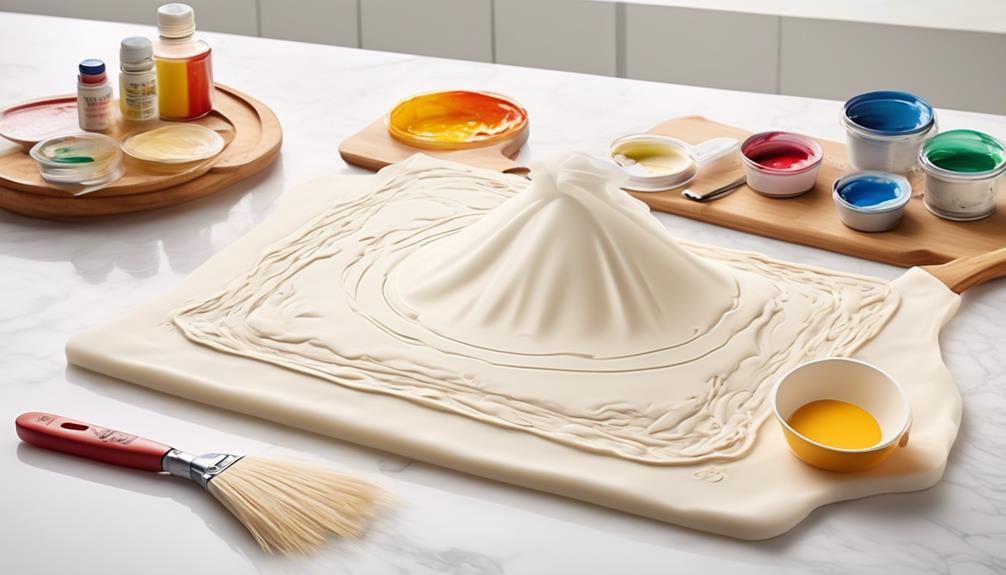
To begin the process of baking acrylic paint, ensure that the painted item is thoroughly dry and has been allowed to air cure for at least 24 hours.
When baking acrylic paint in the oven, follow these steps:
- Preheat the oven to the temperature recommended by the acrylic paint manufacturer, typically between 275°F and 350°F.
- Place the painted item on a lined baking sheet, ensuring that there’s enough space between items for proper heat circulation.
- Bake the item for the specified time, usually around 30 minutes, to allow the acrylic paint to cure and form a strong bond with the surface.
- After baking, allow the item to cool in the oven before removing it to prevent sudden temperature changes that could affect the paint’s finish.
Following these steps for baking acrylic paint will ensure a durable and long-lasting finish on your painted items.
Always remember to maintain proper ventilation and safety precautions when using a household oven for this purpose.
Testing Acrylic Paint Before Baking
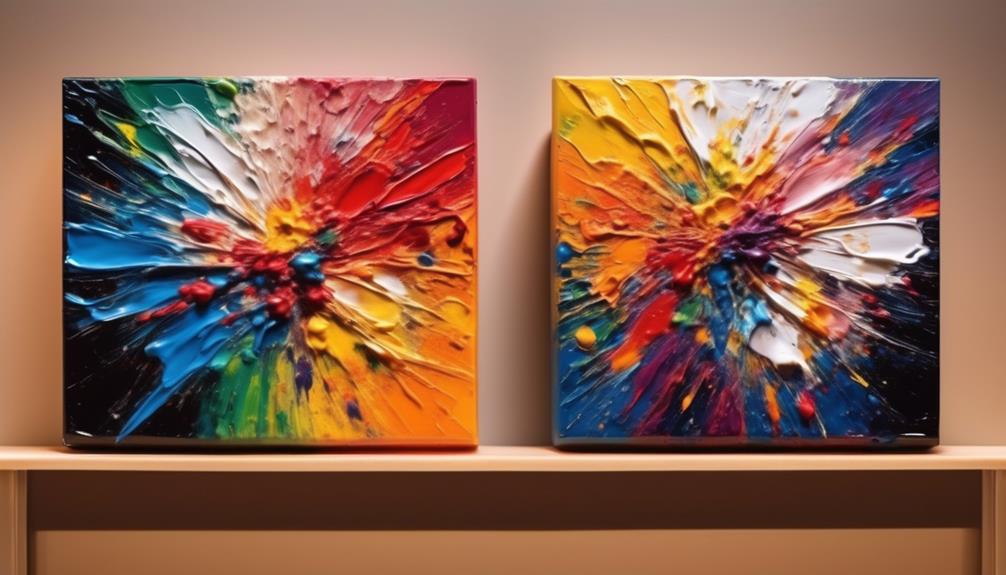
Before baking acrylic paint on ceramics or glass, it’s essential to ensure that the material is oven safe and doesn’t release toxic chemicals. To test the suitability of the paint for baking, a small sample can be painted onto a heat-resistant surface, such as a ceramic tile, and allowed to dry thoroughly.
Once dried, the sample can be baked in the oven according to the recommended temperature and duration. After baking, observe the sample for any changes in color, texture, or adhesion to the surface. If the dried acrylic paint exhibits any adverse effects, such as discoloration or brittleness, adjustments to the baking temperature or duration may be necessary.
It’s crucial to conduct this test before applying the paint to a larger surface to avoid compromising the final result. Additionally, different types of acrylic paint, such as heavy body acrylic paint, may require specific baking methods to achieve the best outcomes.
Baking Acrylic Paint With Multiple Layers

When baking acrylic paint with multiple layers, it’s crucial to ensure that each layer is fully dry before applying the next one. This helps to prevent any potential smudging or blending of colors.
Additionally, heat setting the layers between coats can expedite the drying process, leading to a more durable and vibrant final result.
Layering Acrylic Paint
Layering acrylic paint with multiple coats can enhance the depth and richness of the colors while also strengthening the bond between the paint and the surface. When layering acrylic paint, it’s important to consider the following:
- Use high-quality acrylic paint for the best results.
- Allow each layer to fully dry before applying the next coat to prevent cracking or lifting.
- Consider the viscosity of the paint and adjust it by adding water or a medium to achieve the desired consistency.
- Experiment with different techniques such as dry brushing or glazing to create interesting textures and effects.
Heat Setting Acrylic
To achieve optimal results when heat setting acrylic paint with multiple layers, consider using a heavy body acrylic paint to ensure vibrant colors and better coverage. Heat setting acrylic paint with multiple layers involves a precise process to ensure the layers properly dry and bond. Baking acrylic paint between layers can significantly speed up the drying process, preventing smudging or blending of the paint layers. The table below outlines the recommended steps for heat setting acrylic paint with multiple layers in the oven.
Step Description 1. Apply the first layer of paint 2. Bake the first layer 3. Apply subsequent layers 4. Bake the final layers
Following these steps ensures each layer dries thoroughly and forms a strong bond with the surface, resulting in a professional and long-lasting finish.
Curing Acrylic Paint for Durability

Using a heavy body acrylic paint for baking can significantly enhance the durability of the painted surface. When considering curing acrylic paint for durability, it’s vital to understand the process and its impact. Here are key points to consider:
- Baking acrylic paint helps it form a strong bond with the surface, ensuring long-lasting results.
- Any type of acrylic paint can be used for baking, but heavy body acrylic paint is recommended for vibrant colors and better coverage.
- Baking between coats of paint speeds up the process, allows for painting on a perfectly dry surface, and prevents smudging or blending of paint layers.
- A regular household oven can be used for baking acrylic paint, but it’s important to avoid using the oven for cooking immediately after baking to prevent the release of harmful chemicals, and to air it out before cooking food.
Curing acrylic paint for durability is a crucial step in ensuring the longevity of the painted surface. By following the appropriate guidelines for baking acrylic paint at temperatures suitable for the specific type of paint, the durability and quality of the painted item can be significantly improved.
Cleaning Baked Acrylic Paint

When cleaning baked acrylic paint on ceramics or glass, mild soap and water can be used effectively. It’s important to gently scrub the surface with a soft sponge or cloth to avoid scratching the paint. Rinse the item thoroughly to remove any soap residue and allow it to air dry completely.
Harsh chemicals or abrasive scrubbers should be avoided as they can damage the painted surface. Always handle baked acrylic painted items with care to maintain the quality of the artwork. For glass items, it’s crucial to use a non-abrasive cleaner to prevent scratching. Additionally, consider using a squeegee or a lint-free cloth to ensure a streak-free finish on glass surfaces.
When cleaning ceramics, be mindful of any delicate or intricate areas, and use a soft-bristled brush if necessary. By following these cleaning guidelines, the integrity and longevity of the baked acrylic paint on ceramics and glass can be preserved, allowing the artwork to remain vibrant and durable.
Frequently Asked Questions
How Do You Heat Set Acrylic Paint in the Oven?
We heat set acrylic paint in the oven by following these steps:
- Preheat the oven to 300 degrees Fahrenheit.
- Place the painted item inside the oven.
- Set a timer for 30 minutes.
After baking, we need to let the item cool inside the oven for an hour. This process accelerates drying and helps prevent smudging or blending of paint layers.
It’s important to note that using the appropriate type of acrylic paint suitable for baking is essential. If unsure, it’s always a good idea to consult the manufacturer or experienced artists for guidance.
Can Acrylic Paint Go in the Oven With Polymer Clay?
Yes, acrylic paint can be baked in the oven with polymer clay. By using the oven to cure both the clay and the paint, a strong bond between the two is achieved. This process is essential for creating durable and long-lasting designs on polymer clay surfaces.
However, it’s crucial to follow safety guidelines and ensure proper ventilation when baking acrylic paint in the oven.
Can You Bake All Acrylic Paint?
Yes, all acrylic paint can be baked in the oven. Baking acrylic paint helps ensure a strong bond with the surface. It’s essential for long-lasting results.
Using heavy body acrylic paint is recommended for vibrant colors and better coverage. Baking between coats can speed up the process and prevent smudging.
However, caution is necessary to avoid harmful fumes. Proper ventilation is crucial when using a regular household oven for this purpose.
What Temperature Can You Bake Paint?
We can bake acrylic paint in the oven at 275-300 degrees Fahrenheit, but higher temperatures may cause color changes or make the paint brittle.
It’s crucial to follow the manufacturer’s instructions for the specific acrylic paint being used.
Baking times may vary, but generally, 30 minutes is a good starting point.
After baking, allow the painted item to cool completely before handling.
It’s a delicate process that requires precision to ensure the best results.
Conclusion
In conclusion, baking acrylic paint in the oven is a safe and effective method for achieving vibrant and long-lasting results.
However, it’s essential to exercise caution and ensure proper ventilation to avoid any potential health risks.
Remember, a well-baked acrylic masterpiece isn’t only a work of art, but also a testament to your dedication to the craft.
Happy baking!
- About the Author
- Latest Posts
Introducing Ron, the home decor aficionado at ByRetreat, whose passion for creating beautiful and inviting spaces is at the heart of his work. With his deep knowledge of home decor and his innate sense of style, Ron brings a wealth of expertise and a keen eye for detail to the ByRetreat team.
Ron’s love for home decor goes beyond aesthetics; he understands that our surroundings play a significant role in our overall well-being and productivity. With this in mind, Ron is dedicated to transforming remote workspaces into havens of comfort, functionality, and beauty.
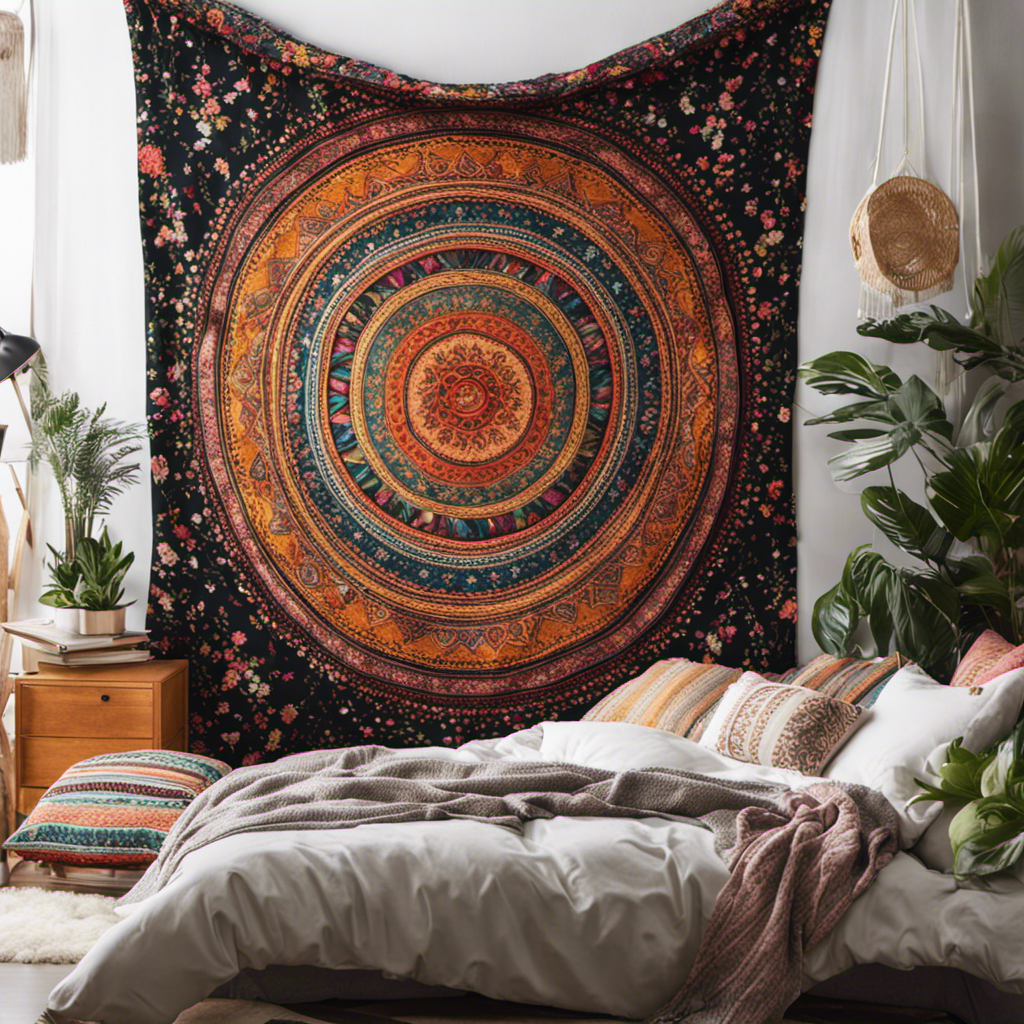
I understand that dorm decor shopping can feel daunting at times. But don’t worry, my fellow college-bound friends! I’ve done the research and I’m here to help you navigate through the sea of choices.
From online retailers to local artisan markets, there are plenty of places to find the perfect pieces to transform your dorm into a cozy haven. So grab your checklist and let’s dive into the world of dorm decor shopping. Trust me, it’s easier than you think.
Key Takeaways
- Online retailers like Amazon and Wayfair offer a wide variety of affordable and trendy dorm decor options.
- Home goods stores and local thrift stores are great places to find unique and affordable items for dorm decor.
- DIY projects can personalize the space while saving money, with ideas such as photo collages and mason jar organizers.
- Local artisan markets and DIY and craft stores provide one-of-a-kind, handmade crafts for personalized dorm decor, while supporting local artists and businesses.
Online Retailers
You can find a wide variety of dorm decor options on online retailers like Amazon and Wayfair. These platforms offer affordable dorm essentials and trendy dorm decor that can transform your dorm room into a stylish and functional space.
When it comes to affordable dorm essentials, online retailers have a range of options, from bedding sets and storage solutions to desk organizers and wall art. You can find products in different styles, colors, and patterns to suit your personal taste and create a cohesive look for your room. Additionally, online retailers often have customer reviews and ratings, allowing you to make informed decisions about the quality and durability of the products you’re purchasing.
Transitioning into the subsequent section about home goods stores, it’s also worth exploring physical stores for a hands-on shopping experience.
Home Goods Stores
When it comes to furnishing a dorm room on a budget, there are several affordable options available. Online retailers offer a wide range of affordable dorm decor, from bedding sets to desk organizers.
Local thrift stores are also a great place to find unique and affordable items that can add personality to any dorm room.
Additionally, DIY dorm decor projects can be a fun and creative way to personalize your space while saving money.
Affordable Options Online
Check out websites like Amazon or Walmart for affordable dorm decor options online. When shopping on a budget, it’s important to explore budget-friendly alternatives and secondhand treasures. These online retailers offer a wide range of products at competitive prices, allowing you to find stylish and affordable pieces to decorate your dorm room. From bedding and curtains to wall art and storage solutions, you can find everything you need to create a cozy and personalized space. Take a look at the table below for some examples of affordable dorm decor options available online:
| Category | Product | Price |
|---|---|---|
| Bedding | Comforter Set | $29.99 |
| Wall Decor | Tapestry | $14.99 |
| Storage | Underbed Organizer | $12.99 |
| Lighting | Desk Lamp | $19.99 |
| Seating | Butterfly Chair | $34.99 |
Local Thrift Stores
If you’re looking for unique and affordable items, consider exploring local thrift stores for hidden treasures. These stores are a goldmine for finding thrift store gems and secondhand treasures that can add character and charm to your dorm room.
Here are four items that you might find at a thrift store:
-
Vintage artwork: Look for old paintings or prints that can bring a touch of nostalgia to your dorm walls.
-
Retro furniture: You might stumble upon a funky chair or a vintage desk that will make your room stand out.
-
Quirky accessories: From quirky lamps to decorative trinkets, thrift stores often have a wide variety of unique items to choose from.
-
Textiles: Don’t forget to check out the selection of throw pillows, blankets, and curtains. You might find some interesting patterns and textures.
By shopping at thrift stores, you not only save money but also contribute to sustainable shopping practices.
Now, let’s move on to DIY dorm decor ideas to further personalize your space.
DIY Dorm Decor
Creating your own dorm room decorations can be a fun and budget-friendly way to add a personal touch to your space. With a little creativity and some basic supplies, you can transform your dorm into a cozy and personalized retreat. Here are a few creative dorm room ideas to get you started:
| Decor Idea | Materials Needed | Instructions |
|---|---|---|
| Photo collage | Photos, string, clips | String the photos on a string and hang them on your wall |
| Washi tape wall art | Washi tape, scissors | Cut the washi tape into desired shapes and stick them on your wall |
| Mason jar organizer | Mason jars, paint | Paint the mason jars in your desired colors and use them to store and organize your desk supplies |
These personalized dorm decorations will not only make your room feel like home, but they will also showcase your unique style and personality. Now, let’s explore another option to find affordable dorm decor: thrift shops.
Thrift Shops
When it comes to finding budget-friendly options for dorm decor, thrift shops are a treasure trove. Not only can you score incredible deals on gently used items, but you’ll also discover unique and eclectic finds that will set your dorm apart from others.
From vintage furniture to one-of-a-kind artwork, thrift shops offer a wide variety of choices that cater to different styles and tastes.
Budget-Friendly Options Available
You can find budget-friendly options for dorm decor at various stores and online retailers. When it comes to creating a stylish and cozy space without breaking the bank, there are plenty of affordable alternatives and secondhand treasures to consider. Here are some ideas to get you started:
- Thrift shops: Explore local thrift shops for unique and inexpensive items such as artwork, throw pillows, and decorative accents.
- Discount stores: Check out discount stores like T.J. Maxx or Marshalls for affordable bedding, rugs, and storage solutions.
- Online marketplaces: Browse online marketplaces like eBay or Facebook Marketplace for great deals on used furniture, lamps, and other dorm essentials.
- DIY projects: Get creative and make your own decor items like wall art or personalized photo displays using inexpensive materials.
By considering these options, you can decorate your dorm room on a budget while still creating a stylish and personalized space.
Now, let’s move on to unique and eclectic finds that will make your dorm room truly stand out.
Unique and Eclectic Finds
For a truly unique and eclectic dorm room, consider exploring local vintage shops and flea markets for one-of-a-kind treasures. These hidden gems are perfect for adding character and charm to your living space.
When searching for vintage dorm decor, keep an eye out for bohemian-inspired tapestries and vintage furniture pieces. The bohemian style, with its vibrant colors and intricate patterns, can create a relaxed and artistic vibe in your room. Look for tapestries with rich textures and bold designs to hang on your walls or use as bedspreads. Vintage furniture, such as a refurbished dresser or a retro desk, can add a touch of nostalgia and sophistication to your dorm. Don’t be afraid to mix and match different eras and styles to create a truly unique look.
As you transition into the next section about department stores, you’ll find that while vintage shops and flea markets offer unique finds, department stores provide a wider range of options for those who prefer a more mainstream style.
Department Stores
One option for purchasing dorm decor is to check out department stores. These stores offer a wide variety of products at budget-friendly prices, making it an ideal choice for students looking to decorate their dorm rooms without breaking the bank.
Department stores often carry a range of quality products, from bedding and curtains to wall art and storage solutions. Here are some options to consider:
- Bedding sets in various styles and colors
- Decorative pillows and throws to add a pop of color
- Wall art, such as posters or framed prints
- Storage solutions like bins and organizers
By shopping at department stores, you can find affordable and stylish dorm decor that meets your budget and personal style.
However, if you’re looking for more unique and handmade items, local artisan markets offer a great alternative.
Local Artisan Markets
After exploring department stores for dorm decor, it’s time to dive into the world of local artisan markets.
These markets are a treasure trove of unique and handmade crafts that can add a touch of personality to any dorm room. Not only will you find one-of-a-kind pieces that can’t be found in mainstream stores, but you’ll also be supporting local artists and their businesses.
Local artisan markets are a great way to discover talented individuals who pour their heart and soul into their creations. From hand-painted artwork and pottery to intricate macramé and tapestries, these markets offer an array of options to suit every taste and style.
So, let’s explore the vibrant world of local artisan markets and find the perfect dorm decor that reflects your individuality and supports the local art community.
As we move forward, let’s now take a look at DIY and craft stores, where you can unleash your creativity and create personalized dorm decor.
DIY and Craft Stores
When you’re feeling crafty and want to add a personal touch to your living space, DIY and craft stores are the perfect destinations to find all the materials and inspiration you need. These stores offer a wide range of crafting materials, from fabrics and paints to beads and ribbons, allowing you to unleash your creativity and bring your ideas to life.
Not only do they provide the necessary supplies, but they also offer a variety of project ideas to get you started. Whether you’re looking to create your own decorative pillows, wall art, or even furniture, these stores have everything you need to embark on your DIY journey.
So grab your shopping list and get ready to explore the endless possibilities at your local craft store.
- Fabrics: Choose from a variety of fabrics in different patterns and textures to create unique home decor items.
- Paints: Find a wide selection of paints in various colors and finishes to add a pop of color to your living space.
- Beads: Use beads to create beautiful jewelry or add embellishments to your decor items.
- Ribbons: Add a touch of elegance with ribbons, perfect for wreaths, bows, and other decorative accents.
Frequently Asked Questions
Are There Any Discounts or Promotions Available for Dorm Decor Purchases at Online Retailers?
There may be discounts or promotions available for dorm decor purchases at online retailers. It’s always a good idea to check the websites of different retailers to see if they are offering any special deals. Many stores also provide seasonal collections, so you might be able to find items that match the current trends and themes. For instance, keeping an eye on the Walmart fall decor release schedule could help you plan your purchases around fresh arrivals and limited-time offers. By shopping strategically, you can save money while still creating a cozy and stylish dorm space.
Can I Find Unique or One-Of-A-Kind Dorm Decor Items at Thrift Shops?
Yes, you can find thrift shop treasures for unique dorm decor items. Thrift shops offer a wide variety of one-of-a-kind pieces that can add character and style to your living space.
Do Department Stores Usually Have a Dedicated Section for Dorm Decor, or Are These Items Scattered Throughout the Store?
When shopping for dorm decor, it’s important to know if department stores have a dedicated section or if items are scattered. Tips for dorm decor shopping include checking out dedicated sections for the best selection.
Are There Any Specific Local Artisan Markets Known for Offering a Wide Range of Dorm Decor Options?
Local artisan markets are a great place to find a wide range of dorm decor options. These markets often showcase unique and handmade items that can add a personal touch to your living space.
Can DIY and Craft Stores Provide Materials and Instructions for Making Custom Dorm Decor Items?
DIY and craft stores are a treasure trove of inspiration and materials for creating custom dorm decor. They offer a wide range of crafting supplies and instructions, making it easy to bring your unique ideas to life.
Conclusion
In conclusion, there are several great options for purchasing dorm decor.
Online retailers like Amazon and Wayfair offer a wide range of products at affordable prices.
Home goods stores like Bed Bath & Beyond provide a curated selection for all styles.
Thrift shops and department stores can also be great places to find unique and budget-friendly items.
Additionally, for those looking to support local artists, artisan markets offer one-of-a-kind pieces.
And for the creative souls, DIY and craft stores provide endless possibilities to personalize your space.
While some may argue that buying dorm decor is unnecessary, creating a comfortable and personalized environment can greatly enhance the college experience and contribute to a sense of home.
So why not invest in making your dorm room a space you love?
- About the Author
- Latest Posts
Meet Katherine, the creative enthusiast at ByRetreat who infuses her boundless passion for design into every remote workspace she crafts. With an innate sense of creativity and an eye for unconventional beauty, Katherine brings a unique and inspiring perspective to the team.
Katherine’s love for design is infectious, and her ability to think outside the box sets her apart. She believes that true artistry lies in embracing a variety of styles and mixing them harmoniously to create captivating spaces. By combining different textures, colors, and patterns, Katherine weaves a tapestry of creativity that breathes life into each remote workspace.
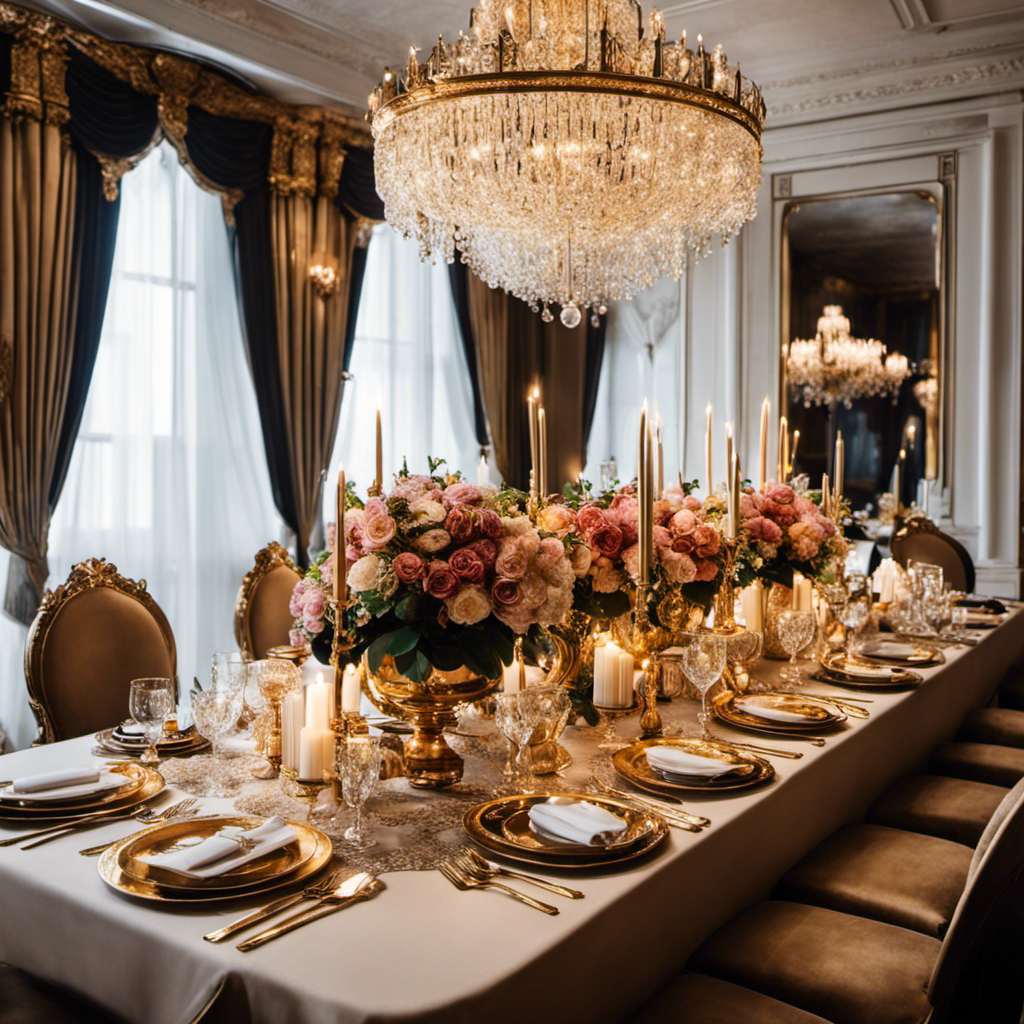
As I enter a room filled with luxurious fabrics, sophisticated accents, and an ambiance of elegance, I am drawn to the charm of bougie decor. This style reflects a sense of luxury and sophistication, demonstrating an appreciation for the finer things in life. Each element, from the plush velvet couches to the shiny metallic finishes, showcases a refined taste that values beauty and indulgence. However, within this lavish setting, one may notice hints of a more relaxed aesthetic—a touch of eclectic charm, perhaps—and wonder how these different elements harmoniously coexist. This is where the boho decor style explained illuminates the contrast between carefree, artistic layering and the structured opulence of bougie design, resulting in a unique blend that feels both deliberate and welcoming.
In this article, I’ll take you on a journey to uncover the origins, key elements, and top trends of bougie decor. Whether you’re looking to incorporate it into your home or simply curious about this lavish aesthetic, prepare to be inspired by the world of bougie decor.
Key Takeaways
- Bougie decor draws inspiration from the luxurious lifestyles of the bourgeoisie and is characterized by elegance, refinement, and a hint of extravagance.
- Luxurious color schemes, opulent furniture choices, and statement-making decor accents are key elements of bougie decor.
- Rich jewel tones, metallic accents, opulent lighting choices, extravagant fabric selections, bold artwork, and high-end materials are commonly used in bougie decor.
- Styling tips include utilizing DIY projects and affordable finds, incorporating bougie decor with other styles, and harmonizing opulence and simplicity.
The Origins of Bougie Decor
You might be wondering where bougie decor originated from. Well, let me take you on a journey through its fascinating history.
Bougie decor, short for bourgeois decor, emerged as a trend in the late 20th century. It draws inspiration from the luxurious and opulent lifestyles of the bourgeoisie, characterized by elegance, refinement, and a hint of extravagance.
The influence of bougie decor on modern interior design cannot be underestimated. With its emphasis on high-quality materials, attention to detail, and a sense of grandeur, it has become a staple in contemporary homes.
Social media has played a significant role in popularizing bougie decor. Platforms like Instagram and Pinterest allow us to showcase our homes, inspiring others to embrace this sophisticated style.
Now, let’s delve into the key elements of bougie decor.
Key Elements of Bougie Decor
When it comes to creating a truly bougie decor, there are several key elements that cannot be overlooked.
Luxurious color schemes are essential for setting the tone and ambiance of the space, with rich jewel tones and metallic accents being particularly popular choices.
Opulent furniture choices, such as tufted velvet sofas and ornate chandeliers, add a sense of grandeur and sophistication to any room.
And finally, statement-making decor accents, such as oversized mirrors and bold artwork, serve as the perfect finishing touches to elevate the space to new levels of opulence.
Luxurious Color Schemes
The bougie decor trend includes using rich, jewel-toned color schemes to create a luxurious and opulent feel. When it comes to choosing colors for a bougie-inspired space, there are a few key elements to consider.
Here are some ideas to help you achieve the perfect color scheme:
-
Luxurious wallpaper options:
-
Opt for wallpapers with intricate patterns and metallic accents to add depth and elegance to the room.
-
Consider bold damask or floral prints in deep, vibrant colors like emerald green or royal blue.
-
Choose wallpapers with a subtle sheen or texture for a touch of glamour.
-
High-end lighting fixtures:
-
Incorporate chandeliers with crystal accents or sleek, modern pendant lights to create a focal point in the room.
-
Use sconces or wall lights with ornate details to add an extra layer of sophistication.
-
Consider incorporating floor lamps with brass or gold finishes for a touch of luxury.
With these luxurious color schemes, complemented by opulent furniture choices, you can create a truly extravagant and stylish bougie decor.
Opulent Furniture Choices
To achieve an opulent feel in your space, consider incorporating furniture choices that exude elegance and luxury. When it comes to creating a bougie decor, opulent lighting choices and extravagant fabric selections are key elements to consider.
Opt for chandeliers with sparkling crystals or sleek, modern floor lamps with gold accents to add a touch of grandeur to your space. As for fabrics, choose rich materials like velvet, silk, or satin in deep jewel tones or metallic hues. These luxurious fabrics not only add texture and depth to your furniture but also create a sense of richness and sophistication.
By carefully selecting opulent lighting choices and extravagant fabric selections, you can transform your space into a lavish haven that exudes luxury and elegance.
And when it comes to making a statement with your decor, don’t forget about the power of statement-making decor accents.
Statement-Making Decor Accents
Consider incorporating statement-making decor accents like bold artwork, unique sculptures, or vibrant throw pillows to add personality and flair to your space. These eye-catching elements can instantly transform a room from ordinary to extraordinary.
To create a truly bougie atmosphere, here are a few ideas to inspire you:
- Statement-making lighting: Hang a chandelier dripping with crystals or install a dramatic pendant light to make a glamorous statement.
- Extravagant home accessories: Display luxurious vases, ornate mirrors, or opulent candle holders to elevate the overall aesthetic of your space.
- Play with textures: Incorporate plush velvet or faux fur pillows, a fluffy rug, or a textured wallcovering to add depth and visual interest.
By incorporating these elements into your home, you can create a space that exudes elegance and sophistication.
Now let’s explore how to seamlessly integrate bougie decor into your home without breaking the bank.
How to Incorporate Bougie Decor in Your Home
Start by adding small touches of bougie decor, such as velvet throw pillows or gold accents, to elevate the style of your home. Incorporating bougie decor doesn’t have to break the bank. There are plenty of affordable options available that can give your space a luxurious touch without emptying your wallet.
Look for stylish yet reasonably priced items like faux fur rugs, mirrored trays, or decorative candle holders. Another challenge when it comes to bougie decor is incorporating it into rented spaces. But fear not! Temporary solutions like removable wallpaper, floor rugs, or even stylish curtains can help transform your rental into a bougie oasis.
Now that you have some affordable and rental-friendly bougie decor ideas, let’s explore the top bougie decor trends that are taking the design world by storm.
Top Bougie Decor Trends
Looking to create a luxurious atmosphere in your home? Check out the top trends in upscale home design that are currently making waves in the industry.
-
Opulent Materials:
-
Velvet: This sumptuous fabric adds a touch of glamour to any space.
-
Marble: A timeless and elegant choice for countertops, flooring, and accents.
-
Gold: Incorporate this precious metal through fixtures, hardware, and accessories.
-
Statement Lighting:
-
Chandeliers: Make a bold statement with a stunning chandelier as the centerpiece of your room.
-
Oversized Pendant Lights: These eye-catching fixtures add drama and sophistication.
-
Customization:
-
Bespoke Furniture: Invest in custom-made pieces that are tailored to your personal style and taste.
-
Artisanal Details: Incorporate unique handcrafted items that add a sense of exclusivity to your space.
With these luxury home trends, you can transform your home into a haven of extravagant interior design. But don’t worry, if you’re on a budget, there are still plenty of ways to achieve a bougie look without breaking the bank.
Budget-Friendly Bougie Decor Ideas
Are you dreaming of a stylish home that exudes luxury but worried about the cost? Look no further!
In this discussion, I’ll share some expert tips on how to achieve affordable luxury home decor that won’t break the bank.
From clever DIY projects to savvy shopping strategies, I’ve got you covered with budget-friendly ideas to create a space that is both chic and affordable.
Affordable Luxury Home Decor
You can create a luxurious atmosphere in your home without breaking the bank by incorporating affordable bougie decor. When it comes to affordable luxury home decor, there are several key elements to consider.
First and foremost, invest in affordable luxury bedding. Opt for high-quality sheets, duvet covers, and pillows that will make your bedroom feel like a five-star hotel.
Next, focus on creating a bougie living room ambiance. Add plush throw blankets, decorative pillows, and a faux fur rug to instantly elevate the space.
Don’t forget about lighting! Incorporate elegant table lamps and statement chandeliers to create a warm and inviting atmosphere.
By incorporating these affordable luxury home decor items, you can transform your space into a haven of sophistication and comfort.
Now, let’s explore how to achieve stylish decor on a budget without compromising on style.
Stylish Decor on Budget
Creating a stylish and budget-friendly living space is possible by utilizing creative DIY projects and incorporating affordable yet trendy furniture pieces.
With a little bit of imagination and resourcefulness, you can achieve affordable glam and high-end looks on a budget. Start by scouring thrift stores or online marketplaces for unique furniture finds that can be easily refurbished or upcycled. A fresh coat of paint or new upholstery can transform an old piece into a chic statement.
Additionally, DIY projects like creating custom artwork or decorative accents using inexpensive materials can add a personal and luxurious touch to your space.
By mixing and matching affordable finds with a few carefully chosen investment pieces, you can create a sophisticated and stylish living environment without breaking the bank.
Now, let’s explore how to achieve bougie decor for small spaces.
Bougie Decor for Small Spaces
If you’re looking to elevate your small space with bougie decor, consider adding luxurious accents and statement pieces. Creating a luxurious apartment decor doesn’t have to be limited by the size of your space. Here are some ideas to help you achieve an elegant small space design:
- Incorporate rich textures: Add velvet or faux fur throw pillows to your couch or bed to create a sense of opulence.
- Focus on statement lighting: Invest in a stunning chandelier or pendant light to instantly upgrade the ambiance of your space.
- Display art pieces: Hang a gallery wall with carefully curated artwork to add a touch of sophistication.
By incorporating these luxurious accents and statement pieces, you can transform your small space into a stylish sanctuary.
Now, let’s take a look at some DIY bougie decor projects that will help you personalize your space even further.
DIY Bougie Decor Projects
Now, let’s explore some DIY projects that will add a touch of luxury to your space.
Creating bougie decor doesn’t have to break the bank; you can achieve a high-end look with a little creativity and some trendy bougie decor colors.
One idea is to transform ordinary glass vases into chic decor pieces by spray painting them in metallic shades like rose gold or champagne.
Another DIY project is to make your own velvet throw pillows using luxurious fabrics in deep jewel tones like emerald green or sapphire blue.
You can also add a touch of glamour to your space by creating a DIY faux fur rug using faux fur fabric and a non-slip rug pad.
These DIY bougie decor ideas will elevate your space and give it a lavish feel.
And when it comes to mixing bougie decor with other styles, you can blend it seamlessly with modern or minimalist aesthetics.
Mixing Bougie Decor With Other Styles
When it comes to interior design, finding the perfect balance between elegance and eclecticism can be a challenging task. However, it is this delicate equilibrium that allows for the creation of truly unique and captivating spaces.
In order to achieve this, one must consider how to harmonize opulence and simplicity, seamlessly integrating luxury and minimalism to create a cohesive and visually stunning design.
Balancing Elegance With Eclecticism
Finding the right balance between elegance and eclecticism is key when it comes to bougie decor. As someone who appreciates the finer things in life, I have learned that creating a space that exudes both sophistication and uniqueness requires careful consideration.
Here are a few tips to help you achieve the perfect balance:
- Mix high-end and vintage pieces to create an eclectic yet refined look.
- Play with textures and patterns to add visual interest without overwhelming the space.
- Incorporate unexpected elements, such as bold colors or unconventional furniture, to create a sense of individuality.
By following these guidelines, you can create a space that is both elegant and eclectic, showcasing your personal style and taste.
As we delve deeper into the concept of bougie decor, let’s explore how to harmonize opulence and simplicity seamlessly.
Harmonizing Opulence and Simplicity
To achieve a harmonious balance between opulence and simplicity in your space, you can focus on selecting luxurious elements that are paired with minimalistic design elements. This concept, often referred to as opulent simplicity or extravagant minimalism, allows you to create a space that exudes elegance and sophistication while maintaining a sense of calm and tranquility. By incorporating high-quality materials, such as marble or velvet, alongside clean lines and neutral color palettes, you can create a space that feels luxurious yet uncluttered. To illustrate this concept further, here is a table that showcases how opulent elements can be paired with minimalistic design elements:
| Opulent Elements | Minimalistic Design Elements |
|---|---|
| Crystal Chandelier | Sleek, Modern Lighting |
| Plush Velvet Sofa | Clean-lined, Minimalist Sofa |
| Ornate Gold Accents | Simple, Geometric Shapes |
Integrating Luxury and Minimalism
You can effortlessly integrate luxury and minimalism by selecting high-quality materials and incorporating clean lines and geometric shapes. Achieving a luxury minimalist design is all about finding the perfect balance between opulence and simplicity.
Here are some key elements to consider when creating a high-end, minimalist aesthetic:
-
High-end home accents: Incorporate luxurious elements such as statement chandeliers, marble countertops, and velvet upholstery to elevate the overall look and feel of your space.
-
Neutral color palette: Opt for a neutral color scheme with pops of rich, jewel tones to create a sophisticated and elegant atmosphere.
-
Minimalist furniture: Choose sleek, streamlined furniture pieces with minimal embellishments to maintain a clean and uncluttered look.
By combining these elements, you can create a luxurious and minimalist space that exudes sophistication and elegance.
Now, let’s explore bougie decor for different rooms in your home, where we’ll dive deeper into specific design ideas and inspirations.
Bougie Decor for Different Rooms in Your Home
The living room is a great place to showcase your bougie decor. It’s where you entertain guests and spend quality time with family, so why not make it lavish? But don’t limit yourself to just the living room! Extend the opulence to other rooms in your home as well, such as the kitchen and bathroom.
In the kitchen, you can elevate your bougie decor by incorporating marble countertops, gold accents, and designer appliances. The combination of luxury and functionality will make your kitchen the envy of every foodie.
In the bathroom, create a spa-like haven with plush towels, scented candles, and a freestanding bathtub. Add a touch of glamour with a crystal chandelier and gilded mirrors.
How to Maintain and Care for Bougie Decor Items
Maintaining and caring for your lavish decor items can ensure their longevity and preserve their exquisite appeal. As someone who appreciates the finer things in life, I understand the importance of taking proper care of delicate and fragile decor.
Here are some tips to help you maintain your bougie decor:
-
Dusting: Regularly dust your decor items using a soft, lint-free cloth to prevent the accumulation of dirt and dust.
-
Cleaning Delicate Fabrics: When dealing with delicate fabrics, such as silk or velvet, spot clean them with a mild detergent and cold water. Avoid rubbing vigorously to prevent damage.
-
Handling Fragile Pieces: When moving or rearranging your decor, handle fragile items with care. Use padded gloves or a soft cloth to protect them from scratches or breakage.
Frequently Asked Questions
How Can I Create a Bougie Decor Look on a Tight Budget?
Creating a bougie decor look on a tight budget is all about being resourceful and creative. By incorporating budget-friendly ideas and following these tips, you can achieve a luxurious look without breaking the bank.
What Are Some Popular Bougie Decor Trends for This Year?
Some popular bougie decor trends for this year include incorporating luxury minimalist elements into your interior design and finding ways to achieve a lavish aesthetic on a budget. Let’s explore these stylish ideas!
Can You Mix Bougie Decor With Other Interior Design Styles?
Yes, you can mix bougie decor with other interior design styles. For example, you can blend bougie decor with minimalist design for a sleek and luxurious look, or incorporate bougie elements in a rustic setting for a unique and eclectic vibe.
What Are Some DIY Projects I Can Do to Incorporate Bougie Decor in My Home?
What are some DIY projects to incorporate bougie decor in my home? I love finding affordable ways to add a touch of luxury. From glam wall art to chic mirrored trays, the possibilities are endless!
Are There Specific Bougie Decor Ideas for Small Spaces?
There are indeed specific bougie decor ideas for small spaces. You can create a luxurious outdoor oasis by incorporating bougie decor for outdoor spaces. Additionally, you can achieve a minimalist style by carefully selecting elegant and high-end pieces.
Conclusion
In conclusion, bougie decor is a fabulous way to elevate your home’s style and create a luxurious atmosphere. By incorporating key elements such as velvet textures, gold accents, and statement pieces, you can transform any space into a chic and sophisticated haven.
Did you know that according to a recent survey, 80% of homeowners who added bougie decor to their living rooms reported feeling happier and more satisfied with their space? So why not indulge in a little bougie decor and bring a touch of luxury into your home? You deserve it!
- About the Author
- Latest Posts
Meet Katherine, the creative enthusiast at ByRetreat who infuses her boundless passion for design into every remote workspace she crafts. With an innate sense of creativity and an eye for unconventional beauty, Katherine brings a unique and inspiring perspective to the team.
Katherine’s love for design is infectious, and her ability to think outside the box sets her apart. She believes that true artistry lies in embracing a variety of styles and mixing them harmoniously to create captivating spaces. By combining different textures, colors, and patterns, Katherine weaves a tapestry of creativity that breathes life into each remote workspace.
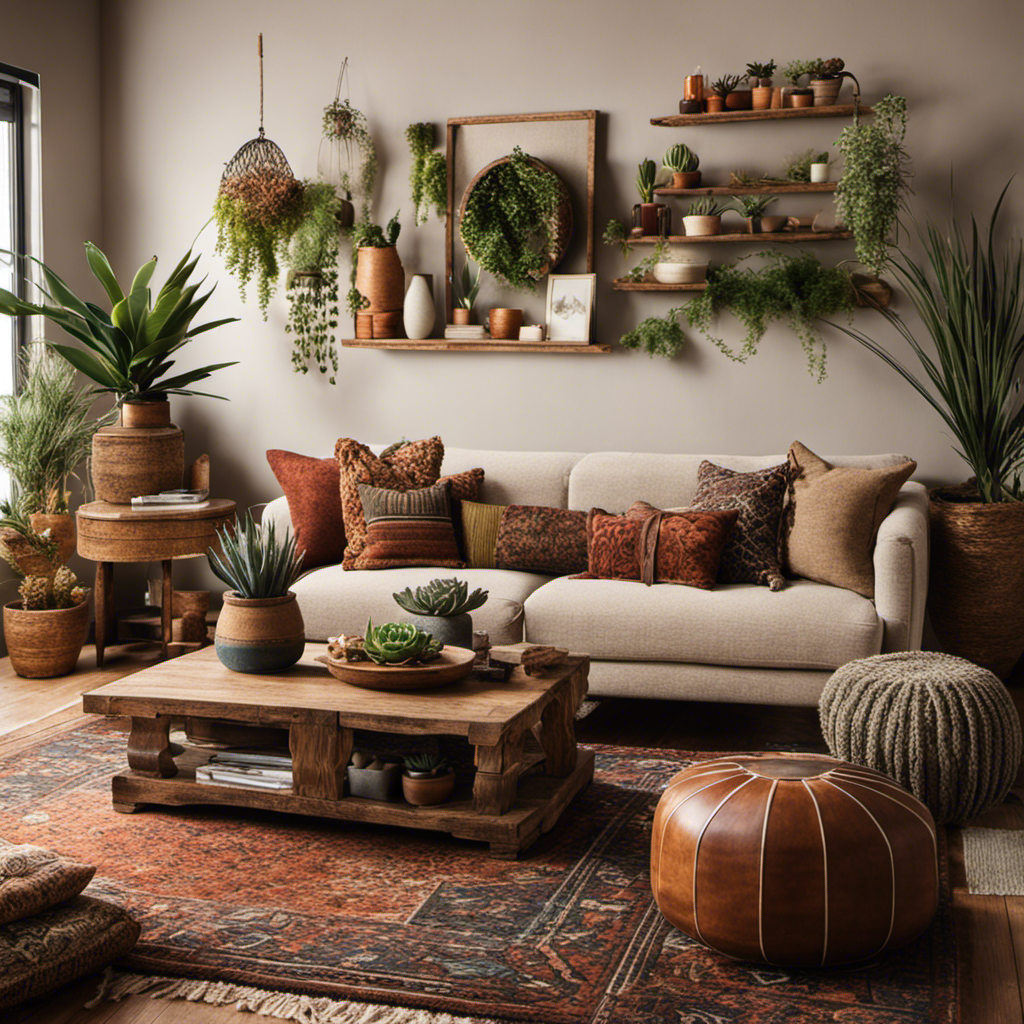
Ah, the age-old dilemma of home decor. It’s a perpetual journey, isn’t it?
Well, fear not, my friends, because I am here to guide you through the labyrinth of design styles and help you uncover your true decor identity.
From the sleek simplicity of minimalism to the free-spirited bohemian vibe, we’ll explore it all.
So sit back, relax, and let’s embark on this delightful quest to discover your perfect decor aesthetic. Trust me, it’ll be worth it.
Key Takeaways
- Eclectic mix allows for a unique and personalized approach to decor styles.
- Minimalism creates a clean and simple look with neutral color schemes and sleek furniture choices.
- Bohemian style is artistic and free-spirited, with bold color palettes and mixing different furniture styles and eras.
- Industrial elements, such as sleek lines and metal accents, can be incorporated into decor for a versatile and durable look.
Understanding Different Decor Styles
To understand different decor styles, you’ll need to explore various design elements and identify what resonates with your personal taste.
One popular style that allows for a unique and personalized approach is an eclectic mix. This style embraces the combination of different design elements from various eras and cultures. It allows you to showcase your individuality by incorporating a range of patterns, textures, and colors.
On the other hand, if you prefer a more minimalistic and clean aesthetic, Scandinavian simplicity might be the right fit for you. This style focuses on functionality, simplicity, and natural materials. It creates a calming and cozy atmosphere with its neutral color palette and streamlined furniture.
Both styles offer distinct characteristics and can be adapted to suit your preferences and lifestyle. Now, let’s delve into exploring minimalist decor aesthetics.
Exploring Minimalist Decor Aesthetics
Exploring minimalist decor aesthetics can create a clean and simple look in your space. Minimalism is all about simplicity and functionality, stripping away unnecessary elements and focusing on the essentials. When designing a minimalist space, consider the following:
- Minimalist Color Schemes: Choose a neutral palette of whites, grays, and earth tones to create a calm and serene atmosphere.
- Minimalist Furniture Choices: Opt for sleek and streamlined furniture with clean lines and minimal ornamentation.
- Declutter and Organize: Keep surfaces clear of unnecessary items and invest in storage solutions to maintain a tidy space.
- Embrace Natural Light: Maximize natural light by using sheer curtains and strategically placing mirrors to enhance the sense of space.
- Texture and Materials: Incorporate texture through natural materials like wood, stone, and linen to add depth and warmth to the minimalist aesthetic.
By embracing minimalist decor, you can create an uncluttered and harmonious space that promotes a sense of calm and tranquility.
Now, let’s transition into embracing bohemian home decor, where vibrant colors and eclectic patterns take center stage.
Embracing Bohemian Home Decor
Get ready to infuse your space with vibrant colors and eclectic patterns by embracing bohemian home decor.
Bohemian style is all about embracing an artistic and free-spirited approach to design, resulting in a space that feels relaxed, laid-back, and full of personality.
One of the defining features of bohemian decor is its bold and rich color palettes. Think deep jewel tones like emerald green, sapphire blue, and ruby red, combined with warm earthy hues like terracotta and mustard yellow.
In terms of furniture choices, bohemian decor encourages mixing and matching different styles and eras. Create a visually interesting space by combining vintage pieces with modern elements.
Don’t be afraid to experiment with textures and materials, such as rattan, macrame, and embroidered fabrics.
By incorporating bohemian color palettes and eclectic furniture choices, you can create a truly unique and vibrant space that reflects your individuality and creativity.
And when you’re ready to add an industrial touch to your bohemian-inspired space, consider incorporating industrial elements into your decor.
Incorporating Industrial Elements Into Your Space
When it comes to incorporating industrial elements into your space, choosing the right furniture is key. Industrial furniture choices often feature sleek lines, metal accents, and a combination of wood and metal materials.
By selecting pieces that embody the ruggedness and simplicity of industrial design, you can create a visually striking and unique atmosphere in your home.
Additionally, enhancing your industrial-inspired space with raw materials such as exposed brick, reclaimed wood, and concrete can further enhance the authenticity and character of the design.
Industrial Furniture Choices
Consider incorporating industrial furniture choices into your decor aesthetic for a unique and modern look. Industrial furniture brings a raw and urban vibe to any space, adding character and personality.
Here are some reasons why industrial furniture is a great choice for your home:
- Versatility: Industrial furniture can be easily integrated into various decor styles, from modern to rustic.
- Durability: Made from sturdy materials like metal and wood, industrial furniture is built to last.
- Functionality: Industrial pieces often feature built-in storage solutions, maximizing space in your home.
- Industrial Lighting Options: Pairing industrial furniture with industrial lighting fixtures creates a cohesive look.
- Repurposing Industrial Furniture: Recycling and repurposing old industrial furniture adds a touch of sustainability to your decor.
By incorporating industrial furniture into your space, you can create a unique and stylish atmosphere that showcases your personal style.
Enhancing your decor with raw materials is a great way to continue this industrial aesthetic throughout your home.
Enhancing With Raw Materials
After exploring the industrial furniture choices that can define a space, it’s time to delve into the world of enhancing your decor with raw materials.
Incorporating raw materials in modern design is a popular trend that brings a touch of nature indoors. By integrating natural elements into your home decor, you can create a warm and organic atmosphere. Natural materials like wood, stone, and metal can add texture and depth to your space.
Consider using reclaimed wood for furniture or accent walls, as it adds character and a rustic charm. Incorporating stone elements, such as marble countertops or a slate fireplace surround, can create a sleek and elegant look. Metal accents, like brass or copper light fixtures, can add a touch of industrial chic.
By incorporating these raw materials, you can create a harmonious and balanced aesthetic in your home.
As we continue our journey through the world of decor aesthetics, let’s now discover the charm of vintage and retro decor.
Discovering the Charm of Vintage and Retro Decor
I love the cozy feel of vintage and retro decor in my home. It brings a sense of nostalgic nostalgia and adds a unique charm to any space. The retro revival is in full swing, with people embracing the styles of the past and incorporating them into their modern interiors.
Here are five reasons why vintage and retro decor is a must-have:
-
Timeless appeal: Vintage pieces have stood the test of time and add character to any room.
-
Eclectic mix: Mixing vintage and retro pieces with modern elements creates a unique and personalized aesthetic.
-
Sustainability: Choosing vintage and retro decor is an eco-friendly choice, as it reduces waste and promotes recycling.
-
Conversation starters: Vintage pieces often have interesting stories behind them, making them great conversation starters.
-
Budget-friendly: Shopping for vintage and retro decor can be more affordable than buying brand new pieces.
Embracing vintage and retro decor is just one way to create a cozy and inviting rustic ambiance in your home.
Creating a Cozy and Inviting Rustic Ambiance
To create a cozy and inviting rustic ambiance, embrace vintage and retro decor. These design elements are perfect for bringing a sense of warmth and nostalgia to your space. Think of a rustic farmhouse or a cozy cabin nestled in the woods, and you’ll start to envision the aesthetic we’re aiming for. Incorporating vintage and retro pieces can instantly transform your home into a charming retreat. Consider using weathered wood furniture, distressed finishes, and antique accessories to create a sense of history and character. Mix and match patterns, textures, and colors to add depth and visual interest. In the table below, I’ve provided some examples of vintage and retro decor items that can help you achieve the cozy rustic ambiance you desire:
| Category | Examples |
|---|---|
| Furniture | Weathered wood dining table, vintage leather armchair |
| Accessories | Vintage wall clock, retro telephone |
| Lighting | Rustic chandelier, industrial-style pendant lights |
| Textiles | Patchwork quilt, faux fur throw |
Frequently Asked Questions
How Do I Choose the Right Decor Style for My Home?
When choosing a decor style for my home, I explore different styles and consider various factors. From influences to personal preferences, I aim to create a cohesive aesthetic that reflects my unique taste and creates a harmonious living space.
What Are Some Budget-Friendly Ways to Update My Decor?
I can help you with budget-friendly decor updates! Get creative with DIY decor ideas like repurposing old items or making your own artwork. It’s a great way to add a personal touch to your space without breaking the bank.
How Can I Incorporate Elements of Different Decor Styles Into My Space?
When incorporating elements of different decor styles, it’s important to find a balance. Mixing vintage pieces with modern ones can create a unique and eclectic look that showcases your personal style.
What Are Some Tips for Creating a Cohesive and Balanced Decor Aesthetic?
To create a cohesive and balanced decor aesthetic, start by creating a color palette that complements your space. Mix patterns and textures for added visual interest. These simple tips will bring harmony to your home.
How Can I Personalize My Decor to Reflect My Own Unique Style and Personality?
There are several ways to infuse personal hobbies into your decor to reflect your unique style and personality. Incorporating sentimental objects and using them as focal points or decorative accents can create a meaningful and personalized space.
-Is My Decor Aesthetic Similar to Catalogue-Style Decor?
When evaluating your home decor, consider if it reflects a decor catalog look. The key to achieving a similar aesthetic is by incorporating clean lines, cohesive color palettes, and minimal clutter. Strive for a polished, elegant feel that resonates with the curated style found in interior design catalogues.
Conclusion
In conclusion, discovering your decor aesthetic can be a delightful and dynamic journey. Understanding different styles allows you to make informed choices that reflect your unique personality and taste.
Whether you embrace the simplicity of minimalism, the free-spiritedness of bohemian decor, the rawness of industrial elements, the nostalgia of vintage and retro styles, or the warmth of rustic ambiance, each aesthetic brings its own charm and character to your space.
By incorporating industry-specific techniques and staying up-to-date with design trends, you can create a visually captivating and harmonious home that truly speaks to your soul.
- About the Author
- Latest Posts
Meet Katherine, the creative enthusiast at ByRetreat who infuses her boundless passion for design into every remote workspace she crafts. With an innate sense of creativity and an eye for unconventional beauty, Katherine brings a unique and inspiring perspective to the team.
Katherine’s love for design is infectious, and her ability to think outside the box sets her apart. She believes that true artistry lies in embracing a variety of styles and mixing them harmoniously to create captivating spaces. By combining different textures, colors, and patterns, Katherine weaves a tapestry of creativity that breathes life into each remote workspace.
-

 Vetted3 weeks ago
Vetted3 weeks ago15 Best Drip Irrigation Systems to Keep Your Garden Thriving
-

 Vetted3 days ago
Vetted3 days ago15 Best Foot Massagers for Neuropathy to Soothe Your Feet and Relieve Discomfort
-

 Vetted1 week ago
Vetted1 week ago15 Best Sports Laundry Detergents for Keeping Your Activewear Fresh and Clean
-
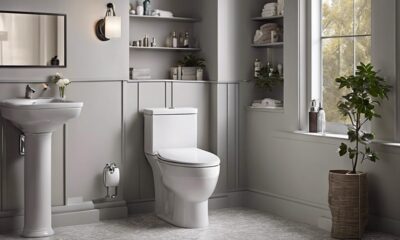
 Vetted2 weeks ago
Vetted2 weeks ago15 Best Tall Toilets for Seniors That Combine Comfort and Safety
-

 Vetted2 weeks ago
Vetted2 weeks ago15 Best Dish Scrubbers to Keep Your Kitchen Sparkling Clean
-

 Beginners Guides4 weeks ago
Beginners Guides4 weeks agoDesigning Your Retreat Center – Essential Tips
-

 Beginners Guides4 weeks ago
Beginners Guides4 weeks agoAre Retreats Profitable
-
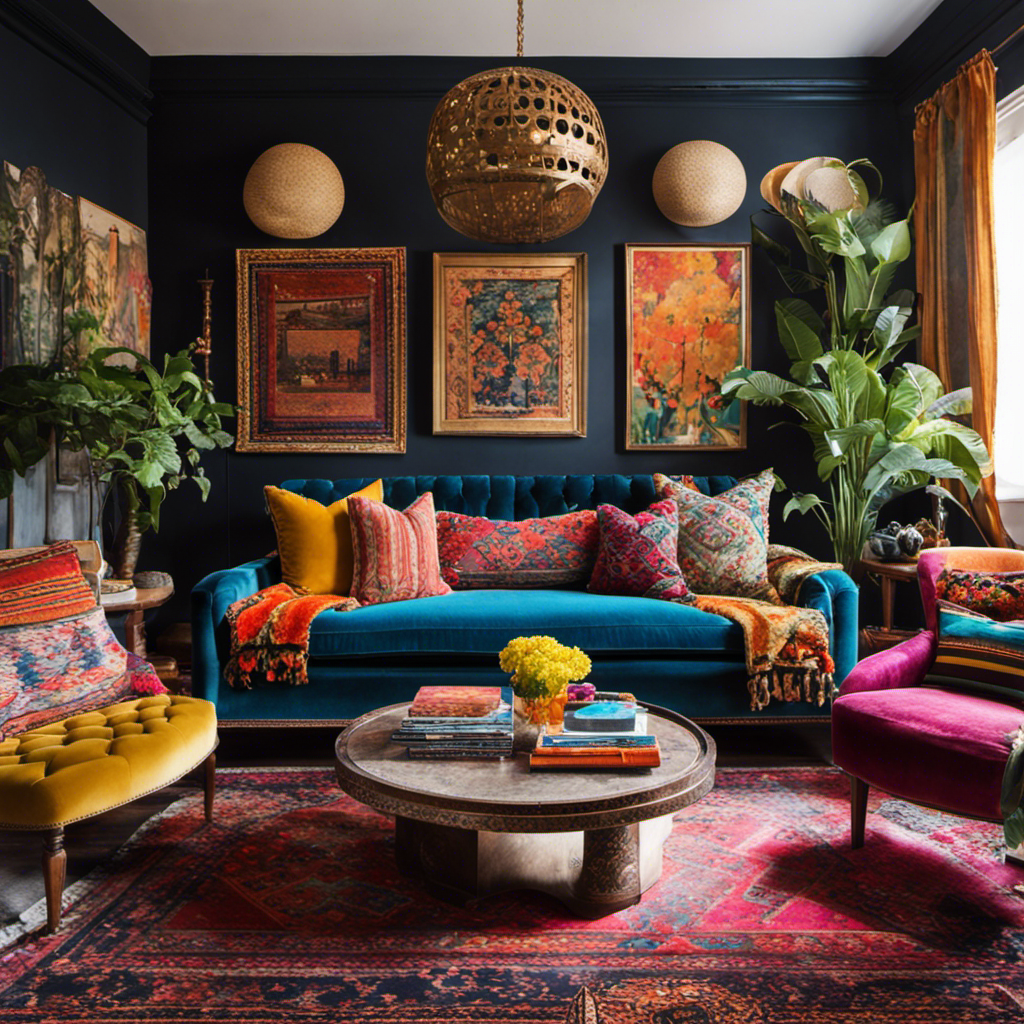
 Decor2 weeks ago
Decor2 weeks agoWhat Is Eclectic Home Decor





